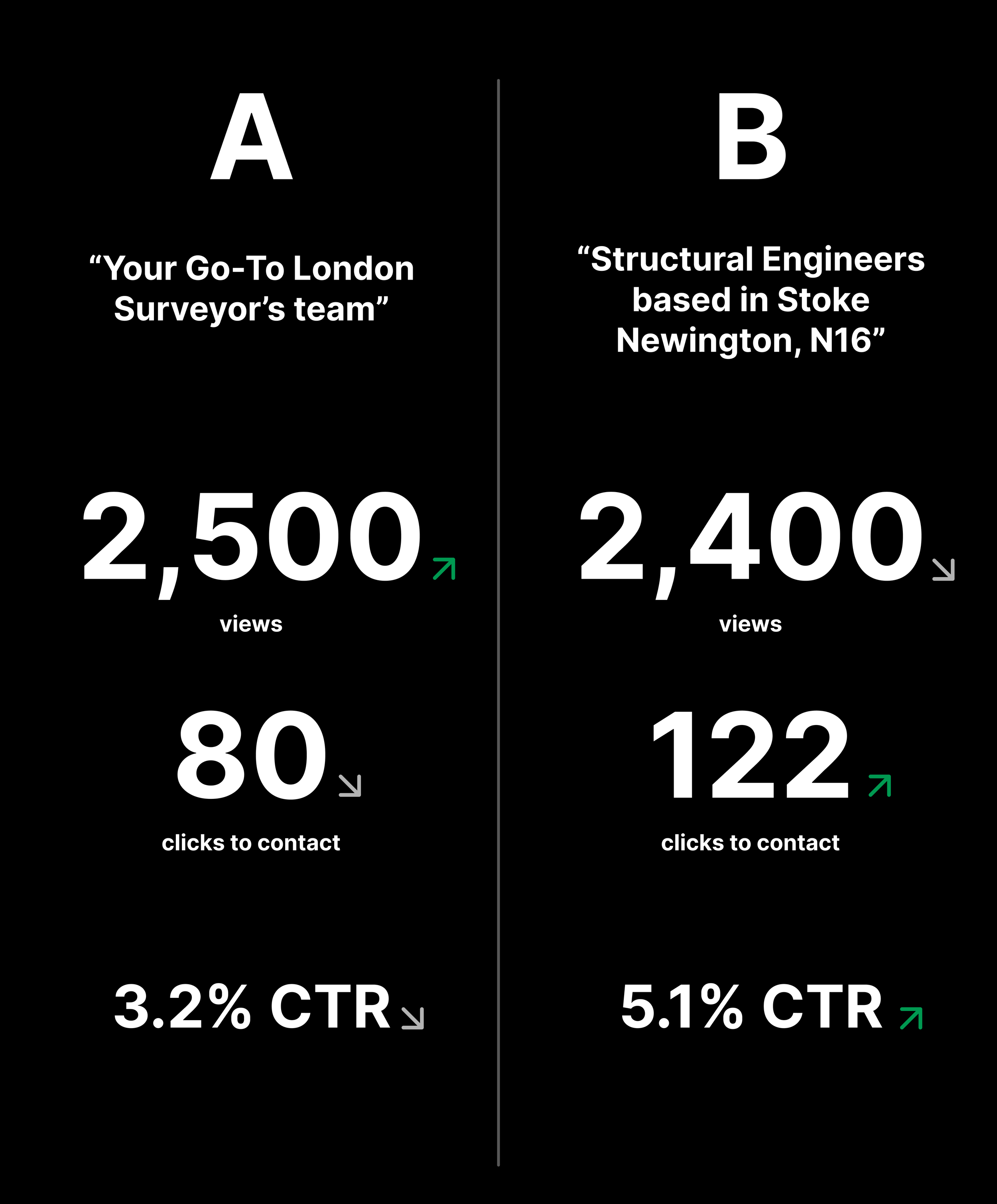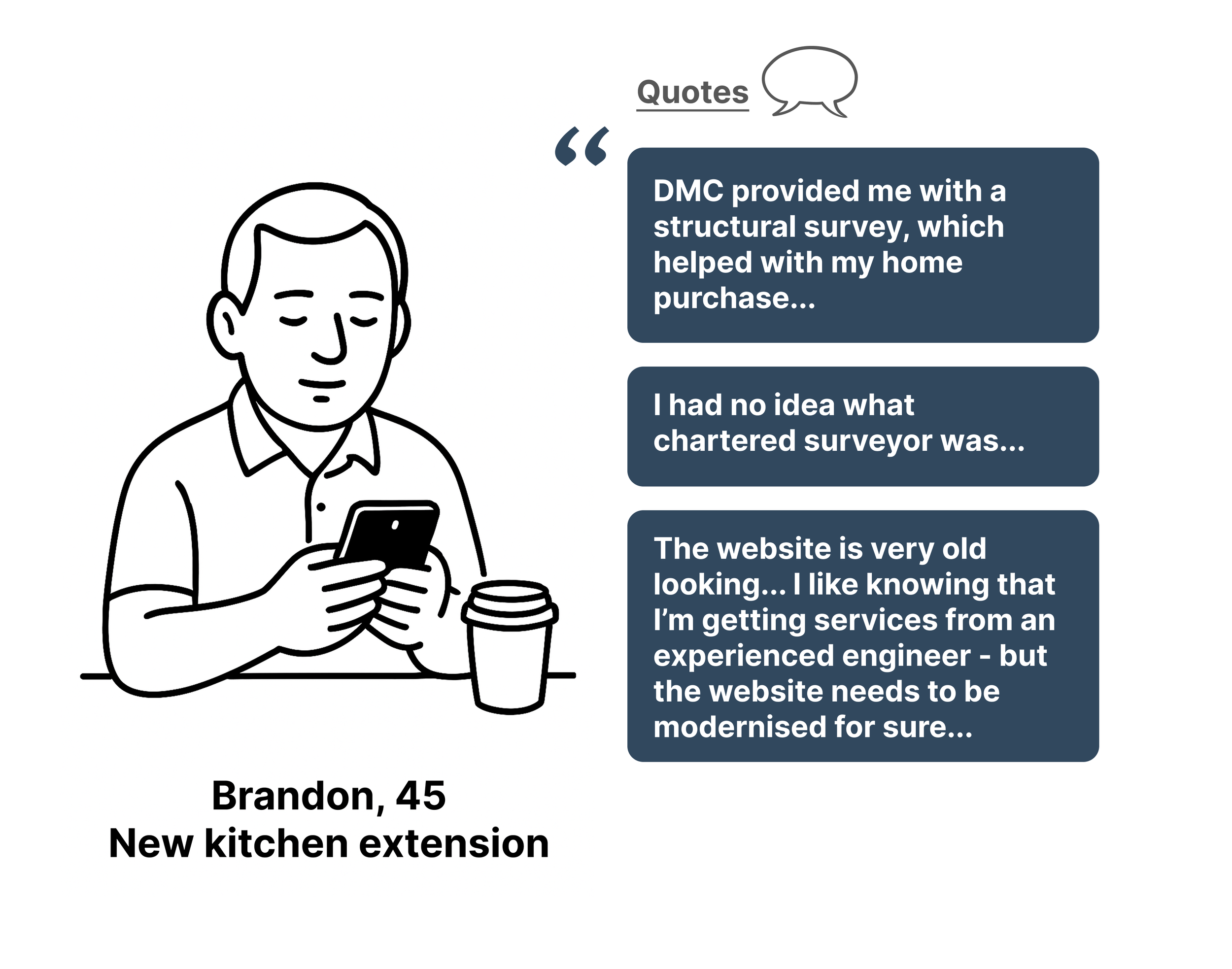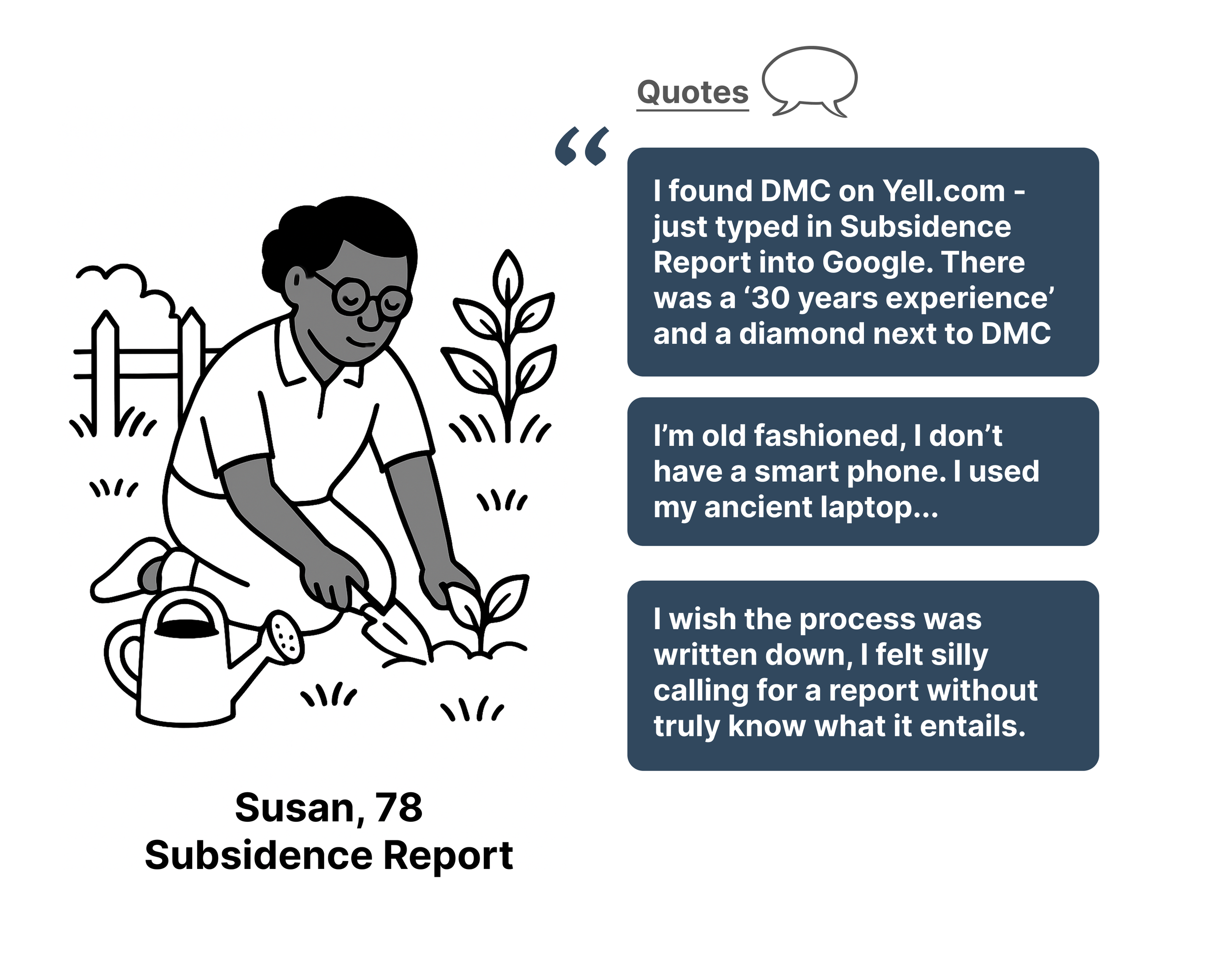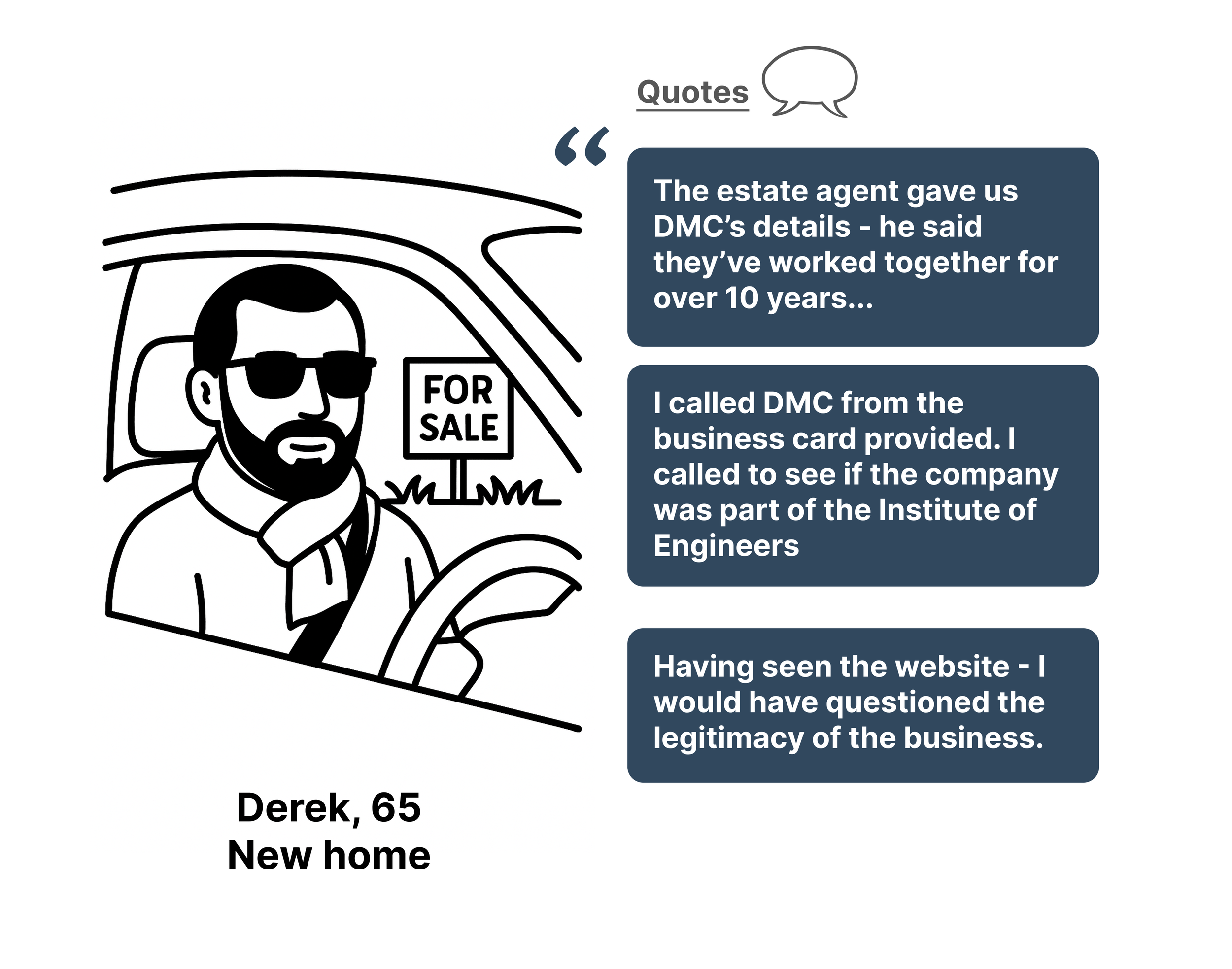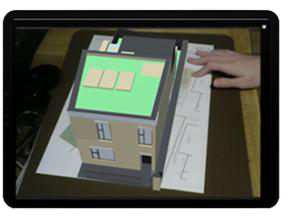DMC
2019 - 2020
Leveraged increased traffic from the redesigned website to test and capture client interest in AR and 3D rendering service.
Executive Summary
Situation: DMC Consulting Engineers was heavily reliant on repeat business and struggling to attract new clients due to an outdated digital presence.
Task: Modernise the company’s website and explore innovative ways to drive new enquiries and business growth.
Action: I led the website discovery, redesign, and user testing process, and introduced an AR tool that visualised client properties in 3D to support building control approvals.
Result: Website sessions increased by 1,200%, Contact clicks up 200%, Bounce rate dropped from 60% to 12%, Revenue increased by 68%.
AR and 3D renders were used to obtain Building Control approval for a client’s new build.
Metrics
1,200%
site sessions from new visitors
68%
increase in company revenue
200%
Clicks to contact
100%
success rate gaining Building Control approval with due to use of 3D renders and AR
Discovery
All participants expressed that DMC’s online presence, especially its main website, appeared outdated and disengaging.
I led interviews with past clients, estate agents, and prospective clients to explore their understanding of surveyors’ services and their impressions of DMC’s brand and digital presence.
During discovery, I identified emerging technology as a white space in the chartered surveying market. Introducing services like AR and VR would give DMC a competitive advantage and create defensible moats against competitors.
New Business Opportunity: 3D renders, AR & VR would put DMC at a huge competitive advantage.
I planned an experiment to gauge whether new and existing customers would express interest in 3D renders and AR solutions.
I saw the UX redesign as a chance to test interest in emerging tech that could bring property proposals to life, driving new revenue, improving efficiency, and reducing building control rejections.
Conversion-based designs
Before introducing 3D renders and AR capabilities, we prioritised a full website redesign to rebuild trust, increase enquiries, and drive more traffic, giving us a stronger foundation to test interest in emerging tech.
I designed DMC’s new website with a mobile-first, conversion-based approach, positioning Contact as the primary call-to-action (CTA). Each page was thoughtfully structured so that a contact button remains visible within two scrolls, helping to maximise the likelihood of users making contact.
Boosted site sessions and contact clicks through SEO keywords and locations targeting
30%
increase in new clients enquiring for DMC’s services.
90 NPS
Gaining Building Control Approval with 3D & AR
Before offering 3D and AR services to clients, the Managing Director needed proof of their impact.
When a client’s new build had repeatedly failed to gain Building Control approval, we used 3D renders and AR to clearly communicate the design, helping secure approval after years of rejection.
I validated the impact of AR and 3D renders by first applying them to a complex project, before pitching them more widely to clients.
After years of failed attempts, a client secured Building Control approval for their new build, thanks to our use of 3D renders and AR to clearly communicate plans.
Mixed reality was used to show both the floor plans of the property, and the 3D renders of the proposed property.
Challenges, Risks and Constraints
Covid-19 and lockdown completely halted DMC’s business
DMC relied on in-person home visits to operate. When lockdowns were introduced, this model was no longer viable, halting projects and significantly impacting the business.
Internal Hesitation Around Emerging Tech
The Managing Director was cautious about introducing 3D renders and AR , not because of cost (as free tools were used), but because no direct competitors were offering emerging tech, making it a perceived risk rather than a proven differentiator.
Boosting Annual Recurring Revenue by 68% Through a Modernised Website and Immersive 3D & AR Services.
DMC
Leveraged increased traffic from the redesigned website to test and capture client interest in AR and 3D rendering service.
Executive Summary
Situation: DMC Consulting Engineers was heavily reliant on repeat business and struggling to attract new clients due to an outdated digital presence.
Task: Modernise the company’s website and explore innovative ways to drive new enquiries and business growth.
Action: I led the website discovery, redesign, and user testing process, and introduced an AR tool that visualised client properties in 3D to support building control approvals.
Result: Website sessions increased by 1,200%, Contact clicks up 200%, Bounce rate dropped from 60% to 12%, Revenue increased by 68%.
AR and 3D renders were used to obtain Building Control approval for a client’s new build.
Metrics
1,200%
Site sessions from new visitors
68%
Increase in company revenue
200%
Clicks to contact
DMC
Year
2019 - 2020
Team
Managing Director
PM
Developer
Designer (Me)
Role
Responsibilities
UX/UI Designer
User Researcher
User Testing
Strategist
Tools
Figma
Adobe Illustrator
Unity
Blender 3D
Planning
The company’s goal is to grow its client base and become less reliant on repeat business from existing clients
DMC Consulting Engineers has provided property surveying services for over 30 years. However, in recent years the company has struggled to attract new client enquiries, signalling a need to modernise its digital presence and explore new business opportunities.
The Bet
A quick audit suggested that DMC was struggling to attract new clients due to several key issues:
An outdated online presence - the website hadn’t been updated since 2004.
The site wasn’t optimised for modern devices, affecting accessibility and usability.
While the UX was simple, the dated visual design created a sense of distrust and reduced credibility.
Even though we had high confidence that the dated website was the cause of the lack of new clients, I still led discovery by interviewed past clients, estate agents, and prospective clients.
DMC’s before website
Discovery
All participants expressed that DMC’s online presence, especially its main website, appeared outdated and disengaging.
We interviewed past clients, estate agents, and prospective clients to explore their understanding of surveyors’ services and their impressions of DMC’s brand and digital presence.
New Business Opportunity: 3D renders, AR & VR would put DMC at a huge competitive advantage.
During discovery, I identified emerging technology as a white space in the chartered surveying market. Introducing services like AR and VR would give DMC a competitive advantage and create defensible moats against competitors.
I planned an experiment to gauge whether new and existing customers would express interest in 3D renders and AR solutions.
I saw the UX redesign as a chance to test interest in emerging tech that could bring property proposals to life, driving new revenue, improving efficiency, and reducing building control rejections.
Problem Statement
All participants identified DMC’s outdated and disengaging online presence, particularly its main website, as a key issue impacting user perception.
Although we only interviewed clients who had previously worked with DMC outside of the website, many admitted they had initially questioned the company’s legitimacy due to its outdated design. This insight led us to make a low-risk, high-impact assumption: potential clients visiting the site were likely dropping off before making contact.
Before introducing 3D renders and AR capabilities, we prioritised a full website redesign to rebuild trust, increase enquiries, and drive more traffic, giving us a stronger foundation to test interest in emerging tech.

End to end design process for new DMC website
i. 5 visitors, 1 click to contact and a 60% bounce rate
I conducted a Rapid Iterative Testing Exercise to assess how efficiently users could complete key client tasks. While the UX presented no major friction points, it became clear that the website needed modernising, particularly to support task completion on mobile devices.
We overcame technical hurdles to implement Hotjar, allowing us to gain valuable behavioural insights. The data helped benchmark site sessions, measure engagement with contact points, and understand traffic sources.

ii. Competitor’s Analysis helped with S.W.O.T. & MoSCoW
I audited competitor websites, online presence, and services across North London. This informed a SWOT analysis for DMC and helped prioritise website features and content using the MoSCoW method.

iii. Mid-Fidelity UX user testing with copy for linguistics analysis
I designed DMC’s new website with a mobile-first, conversion-based approach, positioning Contact as the primary call-to-action (CTA). Each page was thoughtfully structured so that a contact button remains visible within two scrolls, helping to maximise the likelihood of users making contact.

iv. Modernised Design System - WCAG AA/AAA compliant
Following strong results in mid-fidelity user testing, I modernised the design system to ensure full responsiveness across devices with a responsive and fluid grid system, and compliance with WCAG AA/AAA standards. I incorporated high-contrast elements to enhance legibility, but also considered of performance and usability consideration.

v. Reviewing conversion funnels and a few design iterations
We refined DMC’s brand messaging to emphasise local expertise - specifically highlighting Stoke Newington - which helped build trust and improve conversion from site visits to client contact.
However, of the 122 contact clicks, only 10.7% related to Building Surveys, the service where we initially planned to place the ‘Opt-in’ for AR and 3D renders. This insight prompted us to reconsider where and how to introduce emerging tech within the user journey.
The final look
DMC’s Nav Bar clearly shows the firm’s services as well as close proximity to a method of contact.
DMC’s new website answers client’s FAQ in the voice of the customer (VOC).
Every page consists with form to easily submit an enquiry for a quote.
Phone version introduces a widget that allows visitors to quickly dial DMC.
Proving the Value of 3D and AR
Gaining Building Control Approval with 3D & AR
Before offering 3D and AR services to clients, the Managing Director needed proof of their impact. When a client’s new build had repeatedly failed to gain Building Control approval, we used 3D renders and AR to clearly communicate the design, helping secure approval after years of rejection.
I validated the impact of AR and 3D renders by first applying them to a complex project, before pitching them more widely to clients.
After years of failed attempts, a client secured Building Control approval for their new build, thanks to our use of 3D renders and AR to clearly communicate plans.
Mixed reality was used to show both the floor plans of the property, and the 3D renders of the proposed property.
Challenges, Risks and Constraints
Covid-19 and lockdown completely halted DMC’s business
DMC relied on in-person home visits to operate. When lockdowns were introduced, this model was no longer viable, halting projects and significantly impacting the business.
Internal Hesitation Around Emerging Tech
The Managing Director was cautious about introducing 3D renders and AR — not because of cost (as free tools were used), but because no direct competitors were offering emerging tech, making it a perceived risk rather than a proven differentiator.










